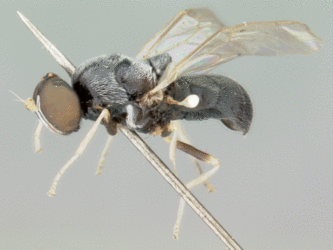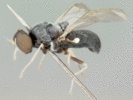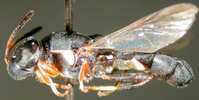Pachygastrinae
Keith Bayless- Abiomyia
- Abrosiomyia
- Acanthinomyia
- Acyrocera argyraspis
- Acyrocerops furcifera
- Adraga
- Ageiton ater
- Aidomyia
- Alliophleps elliptica
- Anargemus basalis
- Ankylacantha keiseri
- Anomalocanthimyia
- Apotomaspis nigeriana
- Argyrobrithes
- Artemita
- Artemitomima mirabilis
- Arthronemina curtilamelleta
- Ashantina antennata
- Aspidacantha
- Aspidacanthina exigua
- Asyncritula
- Aulana
- Berkshiria
- Bistinda castanea
- Blastocera speciosa
- Borboridea
- Brachyodina
- Brachyphleps tristis
- Burmabrithes annulipes
- Cactobia opuntae
- Caenacantha bipartita
- Camptopteromyia
- Cardopomyia robusta
- Cechorismenus flavicornis
- Chalcidomorphina
- Charisina angustifrons
- Chelonomima
- Chlamydonotum nigreradiatum
- Chlorophthalmyia brevicornis
- Cibotogaster
- Clarissimyia pallipes
- Cosmariomyia
- Craspedometopon
- Culcua
- Cyclotaspis inornata
- Cynipimorpha bilimecki
- Dactylacantha plaumanni
- Dactylodeictes
- Dactylotinda saegeri
- Damaromyia
- Diademophora ruandaensis
- Dialampsis argentata
- Diargemus flavipes
- Diastophthalmus flavimanus
- Diplephippium
- Diplopeltina skaifei
- Dochmiocera aurilineata
- Dolichodema
- Drosimomyia
- Ecchaetomyia nigrovittata
- Eicochalcidina
- Eidalimus
- Engicerus major
- Enypnium
- Eufijia
- Eupachygaster
- Evaza
- Gabaza
- Glochinomyia albiseta
- Gnesiomyia crassiseta
- Gnorismomyia flavicornis
- Gobertina
- Goetghebueromyia paradoxa
- Gowdeyana
- Haplofijia simplex
- Hermetiomima
- Hexacraspis sexpinosa
- Himantochaeta cultellata
- Hypoceromys
- Hypoxycera simplex
- Hypselophrum cyphomyioides
- Isomerocera
- Keiseria
- Kerteszmyia ecuadora
- Kolomania
- Lampetiopus umbrosus
- Lasiodeictes niger
- Lenomyia
- Leucacron interruptum
- Leveromyia
- Ligyromyia columbiana
- Lonchegaster
- Lonchobrithes modestus
- Lophoteles
- Lyprotemyia
- Maackiana
- Madagascara seyrigi
- Madagascarina beyeri
- Manotes
- Marangua pygmaea
- Meristocera
- Meristomeringella jamesi
- Meristomeringina
- Meristomerinx
- Monacanthomyia
- Mycterocera contigua
- Myiocavia tomentosa
- Nemodema nudibasis
- Neoacanthina fasciata
- Neochauna variabilis
- Neopachygaster
- Netrogramma consona
- Nyplatys niger
- Obrapa
- Ornopyramis tener
- Otionigera acuticornis
- Oxymyia epacta
- Pachyacantha crassiventris
- Pachyberis stigmaticalis
- Pachygaster
- Panacridops varians
- Panacris
- Pangomyia
- Paracanthinomyia argyrostriata
- Paracechorismenus
- Paradraga omnihirta
- Parastratiosphecomyia
- Parevaza longa
- Pedinocera longicornis
- Pedinocerops
- Pegadomyia
- Peltina
- Peratomastix australis
- Physometopon
- Pithomyia
- Platylobium zurstrasseni
- Platyna
- Platynomorpha doryphora
- Platynomyia
- Popanomyia
- Pristaspis truncata
- Proegmenomyia metallica
- Psapharomydops procerus
- Psapharomys salebrosa
- Psephiocera
- Pseudocyphomyia
- Pseudomeristomerinx nigricornis
- Pseudoxymyia
- Ptilinoxus fallax
- Ptilocera
- Raphanocera turanica
- Rosapha
- Rosaphula handschini
- Salduba
- Saldubella
- Saruga
- Sathroptera flavipes
- Spaniomyia
- Sphaerofijia evazaeformis
- Steleoceromys anthracina
- Sternobrithes
- Stratiosphecomyia variegata
- Strobilaspis
- Strophognathus argentatus
- Synaptochaeta digitata
- Tegocera jamesi
- Thopomyia
- Thylacognathus lativentris
- Tijucameru
- Tinda
- Tindacera quadrispinosa
- Toxopeusomyia flavitarsis
- Trichochaeta
- Trigonocerina flaviventris
- Vittiger schusei
- Weimyia bispinosa
- Xylopachygaster
- Zabrachia
Introduction
Pachygastrinae is a distinctive subfamily of soldier flies. It has the highest generic diversity of any subfamily of Stratiomyidae. Though most are small and black in coloration, the subfamily is also characterized by incredible morphological variation. Some pachygastines are shaped like parasitic wasps, and there are a few large, strikingly colored pachygastrines. Many larvae of Pachygastrinae are predators under bark. Sternobrithes larvae were found at the humus at the base of young Raphia gigantea trees in Africa (Woodley 2001).
Characteristics
Pachygastrinae is distinguished by the loss of vein M3 (Woodley, 2001). The scutellum of many pachygastrines is upturned to nearly vertical.
Discussion of Phylogenetic Relationships
The sole morphological synapomorphy of the group is fairly homoplastic in Stratiomyidae. Woodley (2001) posits that the group may not be monophyletic. The group is supported as monophyletic in Brammer & von Dohlen's (2007) molecular phylogeny of Stratiomyidae, but taxon sampling is not complete.
References
Brammer, C. A. and von Dohlen, C. D. 2007. Evolutionary history of Stratiomyidae (Insecta: Diptera): the molecular phylogeny of a diverse family of flies. Mol Phylogenet Evol. 43(2):660-73.
Pujol-Luz, J. R. and J. Galinkin. 2004. Um novo genero de Pachygastrinae (Diptera: Stratiomyidae) do Brasil. Neotrop. Entomol. 33:35-38.
Woodley, N. E. 2001. A World Catalog of the Stratiomyidae (Insecta: Diptera). Myia 11: 1-473. Backhuys Publishers, Leiden.
Woodley, N. E. 2008. Kerteszmyia, a new genus of Pachygastrinae from the Neotropical Region (Diptera: Stratiomyidae). Zootaxa 1746: 39-45.
Information on the Internet
- Zootaxa: Woodley 2008, includes a key to Neotropical Pachygastrinae with 2 or more scutellar spines.
Title Illustrations

| Scientific Name | Neopachygaster maculicornis |
|---|---|
| Location | Raleigh, Wake Co., North Carolina, USA |
| Acknowledgements | From NCSU Insect Collection; Collected by C. S. Brimley |
| Specimen Condition | Dead Specimen |
| Life Cycle Stage | Adult |
| Image Use |
 This media file is licensed under the Creative Commons Attribution-NonCommercial License - Version 2.5. This media file is licensed under the Creative Commons Attribution-NonCommercial License - Version 2.5.
|
| Copyright |
© Keith Bayless

|
| Scientific Name | Dolichodema fenestratum |
|---|---|
| Location | Liberia; Robertsport Bendu |
| Specimen Condition | Dead Specimen |
| Identified By | James |
| Sex | Female |
| Life Cycle Stage | Adult |
| View | lateral |
| Collection | American Museum of Natural History |
| Type | Holotype |
| Collector | F. M . Snyder |
| Source | Dolichodema fenestratum |
| Image Use |
 This media file is licensed under the Creative Commons Attribution-NonCommercial License - Version 2.5. This media file is licensed under the Creative Commons Attribution-NonCommercial License - Version 2.5.
|
| Copyright |
© Martin Hauser

|
About This Page
Keith Bayless

North Carolina State University, Raleigh, North Carolina, USA
Correspondence regarding this page should be directed to Keith Bayless at
Page copyright © 2008 Keith Bayless
All Rights Reserved.
- First online 28 September 2008
- Content changed 28 September 2008
Citing this page:
Bayless, Keith. 2008. Pachygastrinae. Version 28 September 2008 (under construction). http://tolweb.org/Pachygastrinae/23958/2008.09.28 in The Tree of Life Web Project, http://tolweb.org/










 Go to quick links
Go to quick search
Go to navigation for this section of the ToL site
Go to detailed links for the ToL site
Go to quick links
Go to quick search
Go to navigation for this section of the ToL site
Go to detailed links for the ToL site